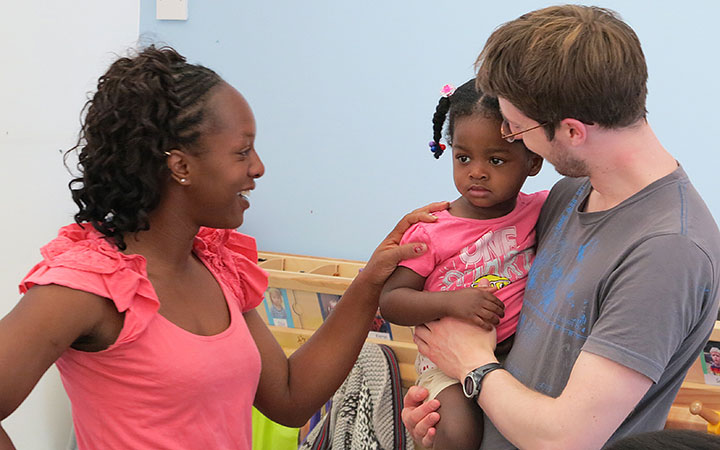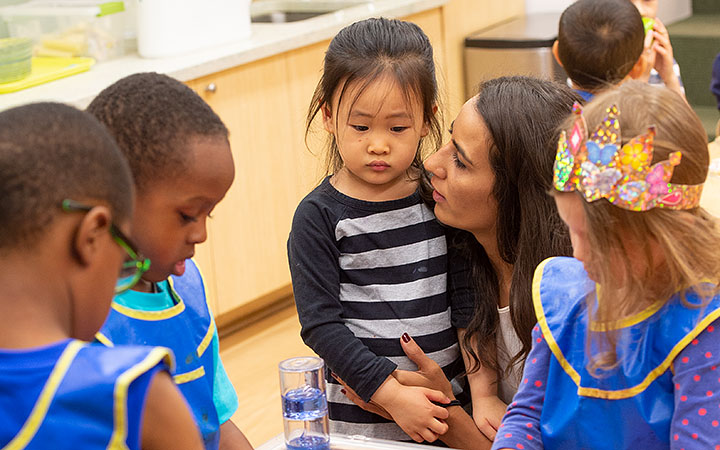Mindful transitions in childcare
Supporting transitions in the early years
| October 2015Mrs. Lopez arrives in her classroom twenty minutes before her first students are scheduled to begin their day. She turns on the lights and reads over her lesson plans as she finishes her coffee. She plans to make the art centre available at the beginning of the day, so she takes out a selection of paper and markers. She also sets out large cardboard blocks and several fire trucks in the centre of the construction area, providing an invitation for interested children to begin building there. When children start to arrive, she is finished arranging her classroom and ready to welcome them with her full attention.
It’s the beginning of the school year in many places, and a time of transition for teachers, children, and families alike. As most of us know, transition is hard! As adults, we mentally prepare ourselves for upcoming transitions, talking ourselves through the upcoming hours and days: “After work, I’ll buy groceries on the way to pick up the baby from child care, and my husband can start dinner while I give her a bath. I have a meeting tomorrow, so I’d better be sure to pack my lunch and iron my suit tonight.” Before we arrive somewhere, we’ve often prepared ourselves for what comes next. Like Mrs. Lopez, we build time into our routines for transitions, so that we can feel ready for what’s to come.
How to support children during transitions
Research shows us that children aren’t yet able to do this on their own. In fact, young children don’t think about the future much at all, unless they are worried about it. This developmental fact means that it’s crucial for important adults in a child’s life to help establish well-planned and predictable transitions, in order to support healthy emotional development. As a teacher, plan to spend energy, effort, and time building relationships with both children and families during times of transition, especially at sensitive moments when children may need extra support.
Three-year-old Elijah is one of the first children to arrive. His face is buried into his father’s neck, and he still looks very sleepy. His father greets Mrs. Lopez warmly, but Elijah doesn’t look up. Elijah’s father explains that their new baby was fussy during the night, and the whole family was awake quite a bit. They are all a little sleepy this morning. Mrs. Lopez invites Elijah’s father to have a seat with him in a cosy chair near the library, and to take his time helping Elijah get settled before he leaves. After a few minutes, Elijah sits up, interested in the books his friends are reading nearby. He climbs off of his father’s lap and snuggles up next to Elizabeth, who is looking at a book full of animals. Once Elijah is settled, his father gives him a kiss, reminds him that his mother will be picking him up today, and heads off to work.
When children arrive, you can ease the transition into your classroom by beginning each day with a warm greeting and a clean slate, leaving any challenges from the previous day behind. As much as possible, keep the beginning of the day predictable. (This includes providing a predictable classroom environment.)
Goodbyes are so important – don’t rush them! Encourage parents and caregivers to devote a few minutes to a meaningful goodbye, instead of trying to sneak away while their child is distracted. Children’s sense of trust and safety in your care can grow when they know that they don’t have to worry about being surprised by a separation. These feelings of connection can allow them to relax and transition to learning.
The time when children are making their way into the classroom provides a great opportunity to check in with families about how things are going at home, and find out if there are any outside factors that may help you to meet the needs of the child each day. Knowing one child is in an especially cheerful mood, and another didn’t get a great night’s sleep, can do wonders in helping you choose the best teaching strategies.
Effects of transitions on children’s development
The value of helping children manage stress, including well-planned and supported transitions, is supported by neuroscience. When we experience stress, levels of a hormone called cortisol spike in the brain. Over time, elevated cortisol levels are associated with damage to the brain and the immune system, which can leave us vulnerable to physical and mental health problems. However, when children’s anxiety and stress are met with sensitive and supportive care, cortisol levels usually drop quickly and with no lasting damage, and children can get on with the business of learning. The more successful experiences children have with teachers and friends, the better they become at managing stress and transitions in the future. Consider time spent as an investment in children’s future ability to tolerate and succeed with transitions.
While arrival and departure times are two of the biggest moments of transition in a school day, there are many smaller transitions during the hours children are in your care. Every time we ask children to stop doing one thing and start doing another (for example, moving from eating lunch to playing outside), that’s a transition! Each of these moments provides opportunities to support and scaffold children’s development.
Managing transitions in childcare mindfully
As your plan your day, build in time for mindful transitions. First, look for ways to reduce the number of times you ask children to change gears. Block schedules and long stretches of child-directed play, both indoors and outdoors, reduce stress and help children build the new friendships that are crucial to social and emotional development and well-being. These growing relationships are especially important for children with cautious temperaments, those in a new setting, and those who are just starting school or care outside the home. During these stretches of play, encourage conversation between children–don’t require quiet. Theorist Lev Vygotsky helped us to understand that children learn best from a competent peer, and from talking about what they are doing while they do it. When they are talking, they are not just building friendships, they are learning!
Helping children to manage their emotions
As children get to know each other, some conflict is inevitable. Remember that self-control and self-regulation are developmental skills – young children cannot access them without your help. Scaffold their emerging abilities by setting a few clear limits (for example, touch friends softly, ask a teacher if you need help, and use quiet voices inside) and enforce them consistently. When boundaries are predictable, children often feel less need to test them, and can spend more time playing and learning.
When things go wrong, acknowledge children’s feelings instead of trying to fix them. Frustration, sadness, and anger are all normal emotions–learning to cope with them is part of growing up. Use validating language, identifying strong emotions as they arise and helping children “feel felt”: “Gosh, that didn’t turn out like you wanted it to. You look disappointed. Sometimes I feel disappointed when I can’t get things to work like I’d planned.” Give children room to move through these very natural feelings, knowing they can safely express and manage them, with your support if needed.
When you deal with challenges in your classroom, make your own feelings obvious for children to see. When you feel frustrated, startled, or disappointed, name the emotion and make it clear to children with your words, facial expressions, and body language, so they don’t have to wonder how you might feel. This is even more important for children who may have chaotic or unpredictable home lives – they need to know that they are not at risk of you losing control.
Elijah and Hunter are playing side by side in the sandbox after lunch. Elijah moves in closer to get a better look at what Hunter is doing. Hunter turns his back to him, blocking his view. Elijah pushes Hunter, and Hunter hits him. Both boys start crying.
Mrs. Lopez runs over, saying, “Whoa! I think we have a problem here! I’m coming!” When she gets to the boys, she asks about what happened. To Elijah, she says, “You wanted to see, and you couldn’t! That’s frustrating! Pushing is not safe–you can ask Hunter to move so you can watch.”
To Hunter, she says, “I’m frustrated that you hit Elijah. I like you, and I don’t like hitting. You can tell him, ‘I need some room! Back up!’ or you can ask me for help next time.”
Arrivals and departures: A chance to connect to a child’s family
Finally, use transition times to build partnerships with families. Let parents and caregivers teach you about their children – they are the experts! Ask how children manage transitions at home, and for ideas about what might be helpful in a school setting. Ask about temperament: How active is their child? How cautious? How much does she rely on routine, and how much does she enjoy new activities? A temperament chart sent home can help you find out more. Consider using a “Getting to Know You” questionnaire that asks families to share information about their family structure, their child’s preferences, and maybe even a wish or two for their child for the year.
Another simple way to set the tone for an open dialogue is to share with families what you’d like them to call you, and then ask how they prefer to be addressed. This simple invitation opens the door for parents to tell you their preferences and often leads to more communication. These strategies should be part of an ongoing commitment to two-way communication with families.
Building extra time into your arrival and pick-up routines supports a developing connection with families, providing natural opportunities to discuss both successes and challenges. Don’t wait until there is a problem to reach out – start building relationships right away. At the beginning of the school year, keep feedback simple and take a strengths-based approach – five positive, strength-related comments for each comment about a concern or problem. There will be plenty of time for more interaction after the school year settles into a routine.
The day is winding down in Mrs. Lopez’s classroom. When Elijah’s mother arrives to pick him up, he is engrossed at the building centre, where he’s stacked big blocks in a tower almost as high as he is tall. Elijah’s face falls when he sees her, worried that he will have to leave his project uncompleted. Seeing his distress, Mrs. Lopez tells Elijah’s mother that he has been very determined and creative in the block centre today, and invites her to pull up a chair and watch him build for a few minutes.
While Mrs. Lopez tucks Elijah’s artwork into his backpack, she is able to greet Elizabeth’s grandmother, who cares for her in the afternoons. They chat about Elizabeth’s developing interest in animals, and Mrs. Lopez mentions a free children’s workshop being held at the zoo during the upcoming weekend. Elizabeth spots her grandmother and comes running. The two happily head home, chatting about the zoo. In the meantime, Elijah has finished his structure. His mother takes a picture of him with it and texts it to his father. Mrs. Lopez helps Elijah pick up the blocks, and hands him his backpack. She wishes them a quieter night, and waves goodbye as they leave the classroom.
Conclusion
As Mrs. Lopez’s classroom illustrates, supported transitions are more likely to be successful ones! When you plan for transitions, including individualised responses for each child, you can reduce stress for children, families, and yourself. Time, energy, and preparation in these special moments can build a classroom routine that runs smoothly, where children thrive and learn, and families feel welcome.









